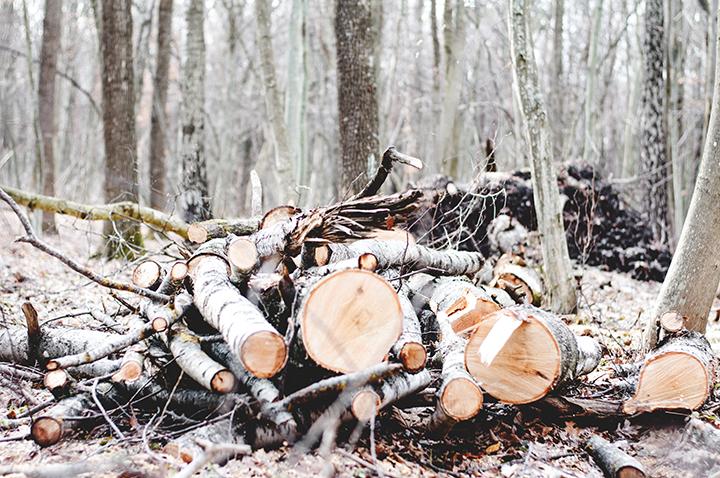| By Pete Earl | |
| Issue #83 • September/October, 2003 |
Harvesting firewood has many rewards: exercise, satisfaction, saving money, and the security of having your own fuel supply for winter warmth. Here are some pointers in the art of cutting your own with maximum safety and minimal effort.
Instead of just cutting green wood and letting it dry over the summer, consider going after aged hardwood, those dead trees that are losing their bark. I call this “vintage firewood” because it has aged like fine wine. If you love a blazing hot fire, this is your ultimate fuel.
Gear to get
A big part of your success will depend on your gear. You’ll need lots of it, but after the initial outlay, your heating costs go way down.
Chain saw. Go as big as you can afford. I struggled for years with a little 1.8 cu. in. engine saw. Now I have a 3.5 cu. in. model that can really cut! I suggest at least a 3 cu. in. saw. Test start it outside the showroom and check for easy starting, smooth idling, and a working bar oiler. Rev the engine, then dip the bar tip near the ground. You should see some sign of oil flying off the chain if the oiler is an automatic one. Don’t get a saw so heavy you’ll have trouble using it. I consider a chain saw very dangerous. Remember that this tool can cut your leg or your head off in two seconds. I took a waterproof marker and marked a long line on the side of the saw 20 inches from the bar tip. Now I have a built-in log measure.
Gas. Get regular gas and add gas stabilizer (such as STA-BIL) to it as soon as you get home. This keeps the gas from gunking up. You’ll also need two cycle oil to add to the gas.
Bar oil. Get a good quality brand by the gallon to save $$.
Gear bag. Every time you head into the woods be prepared to spend the night. All sorts of accidents can happen, so your gear bag could save your life. I use a small canvas bag covered on the outside with a plastic grocery bag. A sharp hatchet and six-inch long wedge are essential for freeing your saw from being pinched in a bad cut. Include a large space blanket, a bunch of hard candy, water bottle, matches, and a signal whistle. You’ll need your bar adjusting wrench occasionally. A spare wool hat and pair of thick gloves are a good idea. If you’re alone, a walkie talkie or cell phone would be great to have. Add a small first aid kit or a war surplus combat bandage in case you suffer a deep cut. I also bring two 12 oz. dry gas bottles, one filled with bar oil and the other with gas mixture. Wrap them tightly in a thick plastic bag to contain any spillage.
|
Clothes. Dress warmly, even in warm weather. A hard hat is a good idea; use a chin strap. Under the hard hat wear a wool hat. Most of your body’s heat loss is through your head. Safety goggles are a must and ear protectors are good if you have a loud saw. Wear tight-fitting clothes with no scarves or necklaces that can get caught in the chain. Thick gloves and boots complete your wardrobe. Don’t forget an orange vest or jacket if it’s hunting season.
Selecting trees
With your fueled and oiled-up saw in one hand and gear bag in the other, you’re ready to hit the woods. I cut almost all oak and maple, avoiding pine and spruce. Even dried, these last two produce a fair amount of creosote, which can cause devastating stove pipe and chimney fires. With the exception of oak, aged wood needs to be found before it hits the ground and rapidly rots away.
Dead trees can be tricky to spot at a distance. Crumbling top branches and peeling bark are good signs. I’ve developed the habit of peeling off a big section of bark at eye level on my walks through the woods. This trick really helps spot trees when cutting time arrives. Since I have to haul my logs out by hand, I try not to cut anything larger than nine inches in diameter. Even aged oak is heavy. Avoid badly rotted trees that fall apart in your hands.
Cutting down
Once you’ve found a suitable dead tree, make sure there is a felling line. A tree hemmed in by others close by isn’t worth bothering with. Clear away the base area and any eyepoker branches near the tree. Make sure you have good footing, especially in snowy and wet weather. Drop your gear bag and saw 10 feet away, out of the felling line. If the tree is thin enough to be shakable, put on all your protective gear and shake the trunk as hard as you can, looking up at the top all the while. This whipping action often cracks off any “widowmaker” branches just waiting to snap off and stab you in the neck! If any break off, rundo not walkseveral yards away. Next, plan the exact felling line. A tree that’s already leaning more than a few degrees in one direction will usually fall that way.
Now comes the big question: to notch or not? Someone could write a small book on the art of notching, but it won’t be me. I almost never bother, unless I’m cutting a large tree. The notch advantage here is that it helps make a clean cut with minimal splintering of the trunk as it falls over. Most trees come down smoothly with just one 20 or 30-degree cut at the base. Make sure any cutting companions are at least 50 feet away, to one side of the felling line. Rev your saw to full speed before cutting and use the teeth at the bar’s base to bite into the wood to help prevent kickback. Always keep all parts of your body out of the saw’s cutting plane. Putting your head over even an idling saw could be dangerous. One slip and your face will meet some sharp teeth when you hit the ground.
Once the tree starts definitely falling, release the throttle and quickly retreat at least 20 feet away at a right angle to the felling direction. Standing behind that tree can be fatal. Either springy top branches or your tree landing on a smaller, springy one can cause the trunk to break free from the cut and slam back like a battering ram faster than you can duck.
Debranching
Debranching is routine so it’s very easy here to get careless and cut toward your leg or in line with your head. Don’t let your guard down. I like to cut off all the branches before sectioning up the tree. Toss them well out of your way and you’re ready to start sectioning. Begin at the top so that the bottom half will be lighter and easier to handle. Using your saw’s measuring mark, make shallow cuts to mark two logs then cut through at the third mark. If your log length is less than 16 inches, add another log length to make your sections about five feet long. As I approach the base of a thick tree, those marks get several inches closer together. This makes the last few sections much lighter and the logs easier to split. Watch for embedded nails, fence wire, and small rocks in the wood. They can damage your chain and cause kickback. When cutting sections flat on the ground, you should cut three quarters of the way through. Do this until you can cut a section with air under it, then roll the trunk a half turn and finish the cuts.
Hauling out
|
Now comes the hardest part, getting those heavy logs home. Cutting, splitting, and stacking in place is fine if you plan to use a pickup or ATV to haul the wood out soon. I want to get those logs back to my woodpile ASAP for two reasons. A sudden ice or snow storm could cut you off from your wood or someone might come along and take a strong liking to your beautiful logs.
I’ve built two log haulers that make the job much easier. My bike and the wood for my sled both came from a landfill dump. For the bike find one with a straight frame and wheels, take off all the gear, fenders, and seat. Make a new log seat out of a 16-inch long piece of 2 by 6-inch lumber. Support that piece with a base built around the seat post. Add boat cleats or large steel rings at each end and tie a 3-foot long piece of thin rope to the far cleat. Turn the handlebars up enough to create a carrying bracket up front. Put on wide tires with rugged tread. Use the bike only in dry weather. Wet leaves or ice or snow make this hauler unsteady because the tires can slip and push the load onto you.
For snowy winter conditions my beefy sled is perfect. It’s made from two 1¾ by 6-inch boards that are 60 inches long. The top three 2 by 4 connectors are each 18 inches long. The lower connectors are several inches off ground level and angled forward to plane the sled up over light snow. Secure all connectors with 4-inch long screws (and a monster screwdriver). Cut some smooth curves on the front ends, then stain all the wood. Drill 4 holes about 2 inches deep at the corners and drop in some 12-inch long bolts to keep the logs in the sled. You’ll need metal runners or the sled won’t slide much. I used sheet aluminum. Take your bottom, curved length measurement and your runner width to a sheet metal shop. Have them cut the length and triple the runner width to allow for side overlaps, then ask them to bend each piece to form a U-shape the exact runner width. Once home, put some shallow notches in the front curve area and nail the metal to each side of each runner with galvanized nails. Drill two rope holes in front and put in a 27-foot length of 3/8 inch rope. I prefer manila because it stays warm and flexible in cold weather. By doubling the rope you reduce its bite into your waist or shoulders.
If you’ll be pulling up steep hills, don’t overload the sled and overexert yourself. Watch out going down slopes, also. Don’t let the sled pick up a lot of speed and run you down. Logs in motion pack a punch.
Splitting
Once you’ve bucked your logs into stove-size pieces, splitting the giant ones can be a chore. I recently moved up from using a splitting maul to a hydraulic splitter. It’s a 4-foot long steel “I” beam with a wedge at one end and a 10-ton jack at the other. Pumping two long handle levers moves the jack and rams a log against the wedge to split it. This beauty requires no gas or electricity and really saves your back. Check tool catalogs such as Harbor Freight Tools for one. It costs about $150.
Store your split logs under some sort of solid roof. Tarps tend to load up with snow and ice, then rip and leak like crazy. Completely dry wood is important for maximum heat output.
Yes, cutting your own firewood is a lot of work, but think of it as a free gym workout. You’ll find that the satisfaction and security of having those hunks of superb fuel stacked out back is fantastic. Of course, saving hundreds or thousands of dollars a year on heating costs is the big reward.
It’s real hard to have too much firewood, so keep on cutting.
















